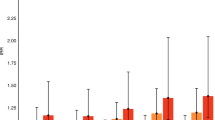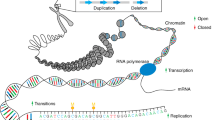Abstract
Genomic copy number variations (CNVs) and increased parental age are both associated with the risk to develop a variety of clinical neuropsychiatric disorders such as autism, schizophrenia and bipolar disorder. At the same time, it has been shown that the rate of transmitted de novo single nucleotide mutations is increased with paternal age. To address whether paternal age also affects the burden of structural genomic deletions and duplications, we examined various types of CNV burden in a large population sample from the Netherlands. Healthy participants with parental age information (n = 6,773) were collected at different University Medical Centers. CNVs were called with the PennCNV algorithm using Illumina genome-wide SNP array data. We observed no evidence in support of a paternal age effect on CNV load in the offspring. Our results were negative for global measures as well as several proxies for de novo CNV events in this unique sample. While recent studies suggest de novo single nucleotide mutation rate to be dominated by the age of the father at conception, our results strongly suggest that at the level of global CNV burden there is no influence of increased paternal age. While it remains possible that local genomic effects may exist for specific phenotypes, this study indicates that global CNV burden and increased father’s age may be independent disease risk factors.


Similar content being viewed by others
References
Aitken R, Koopman P, Lewis S (2004) Seeds of concern. Nature 432:48–52
Alkan C, Coe B, Eichler E (2011) Genome structural variation discovery and genotyping. Nat Rev Genet 12:363–376
Bassett AS, Scherer SW, Brzustowicz LM (2010) Copy number variations in schizophrenia: critical review and new perspectives on concepts of genetics and disease. Am J Psychiatry 167:899–914
Blauw H, Veldink J, van Es M, van Vught P, Saris C, van der Zwaag B et al (2008) Copy-number variation in sporadic amytrophic lateral sclerosis: a genome-wide screen. Lancet Neurol 7:319–326
Blauw H, Al-Chalabi A, Andersen P, van Vught P, Diekstra F, van Es M et al (2010) A large genome scan for rare CNVs in amyotrophic lateral sclerosis. Hum Mol Genet 19:4091–4099
Buizer-Voskamp JE, Laan W, Staal WG, Hennekam E, Aukes M, Termorshuizen F et al (2011a) Paternal age and psychiatric disorders: findings from a Dutch population registry. Schizophr Res 129:128–132
Buizer-Voskamp JE, Muntjewerff J, Strengman E, Sabatti C, Stefansson H, GROUP Consortium et al (2011b) Genome-wide analysis shows increased frequency of copy number variation deletions in Dutch schizophrenia patients. Biol Psychiatry 70:655–662
Cannon M (2009) Contrasting effects of maternal and paternal age on offspring intelligence. PLoS Med 6:e1000042
Carvalho CM, Zhang F, Lupski JR (2010) Genomic disorders: a window into human gene and genome evolution. PNAS 107:1765–1771
Conrad D, Keebler J, DePristo M, Lindsay S, Zhang Y, Casals F et al (2011) Variation in genome-wide mutation rates within and between human families. Nat Genet 43:712–714
Crow J (2003) Development: there’s something curious about paternal-age effects. Science 301:606–607
Curley J, Mahoodh R, Chanmpagne F (2011) Epigenetics and the origins of paternal effects. Horm Behav 59:306–314
Durkin M, Maenner M, Newschaffer C, Lee L, Cunniff C, Daniels J et al (2008) Advanced parental age and the risk of autism spectrum disorder. Am J Epidemiol 168:1268–1276
Fan Y, Jayakar P, Zhu H, Barbouth D, Sacharow S, Morales A et al (2007) Detection of pathogeneic gene copy number variations in patients with mental retardation by genomewide oligonucleotide array comparative genomic hybridization. Hum Mutat 28:1124–1132
Fokkema T, de Valk H, de Beer J, van Duin C (2008) The Netherlands: childbearing within the context of a “poldermodel” society. Demographic Res 19:743–794
Goriely A, McVean G, Röjmyr M, Ingemarsson B, Wilkie A (2003) Evidence for selective advantage of pathogenic FGFR2 mutations in the male germ line. Science 301:643–646
Grewal J, Carmichael S, Yang W, Shaw G (2011) Paternal age and congenital malformations in offspring in California, 1989–2002. Matern Child Health J 16:385–392
Hehir-Kwa JY, Rodríguez-Santiago B, Vissers LE, de Leeuw N, Pfundt R, Buitelaar J et al (2011) De novo copy number variants associated with intellectual disability have a paternal origin and age bias. J Med Genet 48:776–778
Hofman A, Breteler M, van Duijn C, Janssen H, Krestin G, Kuipers E et al (2009) The Rotterdam Study: 2010 objectives and design update. Eur J Epidemiol 24:553–572
Hurst L, Ellegren H (2002) Mystery of the mutagenic male. Nature 420:365–366
Hyman S (2007) Can neuroscience be integrated into the DSM-V? Nat Rev Neurosci 8:725–732
Iossifov I, Ronemus M, Levy D, Wang Z, Hakker I, Rosenbaum J et al (2012) De novo gene disruptions in children on the autistic spectrum. Neuron 74:285–299
Itsara A, Cooper GM, Baker C, Girirajan S, Li J, Absher D et al (2009) Population analysis of large copy number variants and hotspots of human genetic disease. Am J Hum Genet 84:148–161
Itsara A, Wu H, Smith J, Nickerson D, Romieu I, London S et al (2010) De novo rates and selection of large copy number variation. Genome Res 20:1469–1481
Jakobsson M, Scholz S, Scheet P, Gibbs J, VanLiere J, Fung H et al (2008) Genotype, haplotype and copy-number variation in worldwide human populations. Nature 451:998–1003
Kiemeney L, Thorlacius S, Sulem P, Geller F, Aben K, Stacey S et al (2008) Sequence variant on 8q24 confers susceptibility to urinary bladder cancer. Nat Genet 40:1307–1312
Kong A, Frigge M, Masson G, Besenbacher S, Sulem P, Magnusson G et al (2012) Rate of de novo mutations and the importance of father’s age to disease risk. Nature 488:471–475
Krishnaswamy S, Subramaniam K, Ramachandran P, Indran T, Aziz J (2011) Delayed fathering and risk of mental disorders in adult offspring. Early Hum Dev 87:171–175
Lopez-Castroman J, Gomez D, Carballo Belloso J, Fernandez-Navarro P, Perez-Rodriguez M, Villamor I et al (2009) Differences in maternal and paternal age between schizophrenia and other psychiatric disorders. Schizophr Res 116:184–190
Lupski J, Stankiewicz P (2005) Genomic disorders: molecular mechanisms for rearrangements and conveyed phenotypes. PLoS Genet 1:e49
Malaspina D, Reichenberg A, Weiser M, Fennig S, Davidson M, Harlap S et al (2005) Paternal age and intelligence: implications for age-related genomic changes in male germ cells. Psychiatr Genet 15:117–125
Marioni J, Thorne N, Valsesia A, Fitzgerald T, Redon R, Fiegler H et al (2007) Breaking the waves: improved detection of copy number variation from microarray-based comparative genomic hybridization. Genome Biol 8:R228
McClellan J, Susser E, King M (2007) Schizophrenia: a common disease caused by multiple rare alleles. Br J Psychiatry 190:194–199
Neale B, Kou Y, Liu L, Ma’ayan A, Samocha K, Sabo A et al (2012) Patterns and rates of exonic de novo mutations in autism spectrum disorders. Nature 485:242–245
Olsen J, Zhu JL (2009) Re: “Advanced parental age and the risk of autism spectrum disorder”. Am J Epidemiol 169:1406
O’Roak B, Vives L, Girirajan S, Karakco E, Krumm N, Coe B et al (2012) Sporadic autism exomes reveal a highly interconnected protein network of de novo mutations. Nature 485:246–250
Pang A, MacDonald J, Pinto D, Wei J, Rafiq M, Conrad D et al (2010) Towards a comprehensive structural variation map of an individual human genome. Genome Biol 11:R52
Penrose L (1955) Parental age and mutation. Lancet 266:312–313
Redon R, Ishikawa S, Fitch KR, Feuk L, Perry GH, Andrews TD et al (2006) Global variation in copy number in the human genome. Nature 444:444–454
Risch N, Reich E, Wishnick M, McCarthy J (1987) Spontaneous mutation and parental age in humans. Am J Hum Genet 41:218–248
Sanders S, Murtha M, Gupta A, Murdoch J, Raubeson M, Willsey A et al (2012) De novo mutations revealed by whole-exome sequencing are strongly associated with autism. Nature 485:237–241
Sebat J, Lakshmi B, Malhotra D, Troge J, Lese-Martin C, Walsh T et al (2007) Strong association of de novo copy number mutations with autism. Science 316:445–449
Sibbons C, Morris J, Crolla J, Jacobs P, Thomas N (2012) De novo deletions and duplications detected by array CGH: a study of parental origin in relation to mechanisms of formation and size of imbalance. Eur J Hum Genet 20:155–160
Singh N, Muller C, Berger R (2003) Effects of age on DNA double-strand breaks and apoptosis in human sperm. Fertil Steril 80:1420–1430
Stefansson H, Rujescu D, Cichon S, Pietiläinen OPH, Ingason A, Steinberg S et al (2008) Large recurrent microdeletions associated with schizophrenia. Nature 455:232–236
The International Schizophrenia Consortium (2008) Rare chromosomal deletions and duplications increase risk of schizophrenia. Nature 455:237–241
Thomas N, Durkie M, Potts G, Sandford R, Van Zyl B, Youings S et al (2006) Parental and chromosomal origins of microdeletion and duplication syndromes involving 7q11.23, 15q11-q13 and 22q11. Eur J Hum Genet 14:831–837
Thomas N, Morris J, Baptista J, Ng B, Crolla J, Jacobs P (2010) De novo apparently balanced translocations in man are predominantly paternal in origin and associated with a signficant increase in paternal age. J Med Genet 47:112–115
Tiemann-Boege I, Navidi W, Grewal R, Cohn D, Eskenazi B, Wyrobek A et al (2002) The observed human sperm mutation frequency cannot explain the achondroplasia paternal age effect. PNAS 99:14952–14957
van Es M, van Vught P, Blauw H, Franke L, Saris C, van den Bosch L et al (2008) Genetic variation in DPP6 is associated with susceptibility to amyotrophic lateral sclerosis. Nat Genet 40:29–31
van Es M, Veldink J, Saris C, Blauw H, van Vught P, Birve A et al (2009) Genome-wide association study identifies 19p13.3 (UNC13A) and 9p21.2 as susceptibility loci for sporadic amyotrophic lateral sclerosis. Nat Genet 41:1083–1087
Vrijenhoek T, Buizer-Voskamp JE, van der Stelt I, Strengman E, GROUP Consortium, Sabatti C et al (2008) Recurrent CNVs disrupt three candidate genes in schizophrenia patients. Am J Hum Genet 83:504–10
Wang K, Li M, Hadley D, Liu R, Glessner J, Grant SF et al (2007) PennCNV: an integrated hidden Markov model designed for high-resolution copy number variation detection in whole-genome SNP genotyping data. Genome Res 17:1665–1674
Acknowledgments
We gratefully acknowledge the contribution of the participants. Data was obtained from different studies that were previously supported by The Netherlands Organization for Scientific Research (NWO), the Prinses Beatrix Fonds, VSB Fonds, the Research Institute for Diseases in the Elderly, the Netherlands Genomics Initiative, the National Institute for Mental Health (NIMH), The National Institute for Drug Abuse (NIDA), the European Commission, and the Radboud University Nijmegen Medical Center, the Erasmus Medical Center Rotterdam, and the University Medical Center Utrecht in The Netherlands. We thank Nelson Freimer for critically reading the manuscript. The authors report no biomedical financial interest or potential conflicts of interest.
Conflict of interest
The authors have no conflicts of interest with this work.
Ethical standards
This study complies with the current laws of the Netherlands.
Author information
Authors and Affiliations
Corresponding author
Additional information
The authors J. E. Buizer-Voskamp, H. M. Blauw and M. P. M. Boks have contributed equally.
Electronic supplementary material
Below is the link to the electronic supplementary material.
Rights and permissions
About this article
Cite this article
Buizer-Voskamp, J.E., Blauw, H.M., Boks, M.P.M. et al. Increased paternal age and the influence on burden of genomic copy number variation in the general population. Hum Genet 132, 443–450 (2013). https://doi.org/10.1007/s00439-012-1261-4
Received:
Accepted:
Published:
Issue Date:
DOI: https://doi.org/10.1007/s00439-012-1261-4




